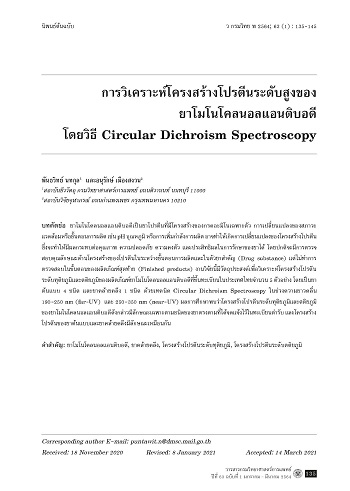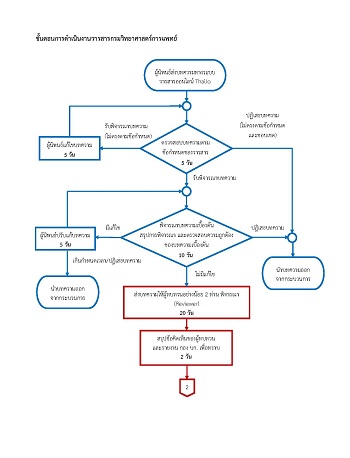Higher Order Analysis of Protein Structure of Therapeutic Monoclonal Antibody by Circular Dichroism Spectroscopy
Keywords:
Monoclonal antibody products, Biosimilars, Secondary protein structure, Tertiary protein structureAbstract
Therapeutic monoclonal antibodies (mAb) are protein drugs that have a unique amino acid structure. When there are any changes in the structure due to environmental condition; pH, temperature or increasing production. Their safety, quality and efficacy may be affected. The determination of their higher order protein structure is performed in the in-process control and drug substances but not in the finished products. The purpose of this study was to analyze the protein structure of 5 mAb drugs (4 reference drugs and 1 biosimilar drug) registered in Thailand, using the circular dichroism spectroscopy technique in two ranges of wavelengths: 190-250 nm (far-UV) and 250-350 nm (near-UV). The study demonstrated that the protein structures of all samples showed the specific pattern depending on the product type and the results were conformed to those as their registrations. In addition, we found that the protein structure of the biosimilar mAb drug was similar to its reference drug.
References
วิชชุดา จริยะพันธุ์, ฐิตาภรณ์ ภูติภิณโยวัฒน์, สายวรุฬ จดูรกิตตินันท์. คุณลักษณะของไกลแคนในยาโมโนโคลนอลแอนติบอดีที่จำหน่ายในประเทศไทย. ว กรมวิทย พ 2560; 59(2) : 104-14.
Parr MK, Montacir O, Montacir H. Physicochemical characterization of biopharmaceuticals. J Pharm Biomed Anal 2016; 130: 366-89.
Wei Y, Thyparambil AA, Latour RA. Protein helical structure determination using CD spectroscopy for solutions with strong background absorbance from 190-230 nm. Biochim Biophys Acta 2014; 1844(12): 2331-7.
พิมพ์เพ็ญ พรเฉลิมพงศ์, นิธิยา รัตนาปนนท์. โครงสร้างของโปรตีน (Protein structure). [ออนไลน์]. 2562; [สืบค้น 27 เม.ย. 2562]; [5 หน้า]. เข้าถึงได้ที่: URL: https://sites.google.com/site/sarchiwmolekul/home/portin-laea-krd-xa-mi-no-proteins/khorngsrang-khxng-portin-protein-structure.
Pisupati K, Benet A, Tian Y, Okbazghi S, Kang J, Ford M, et al. Biosimilarity under stress: a forced degradation study of Remicade® and Remsima™. MAbs 2017; 9(7): 1197-209.
Jung SK, Lee KH, Jeon JW, Lee JW, Kwon BO, Kim YJ, et al. Physicochemical characterization of Remsima. MAbs 2014; 6(5): 1163-77.
Hong J, Lee Y, Lee C, Eo S, Kim S, Lee N, et al. Physicochemical and biological characterization of SB2, a biosimilar of Remicade® (infliximab). MAbs 2017; 9(2): 365-83.
Magnenat L, Palmese A, Fremaux C, D'Amici F, Terlizzese M, Rossi M, et al. Demonstration of physicochemical and functional similarity between the proposed biosimilar adalimumab MSB11022 and Humira®. MAbs. 2017; 9(1): 127-39.
Cho IH, Lee N, Song D, Jung SY, Bou-Assaf G, Sosic Z, et al. Evaluation of the structural, physicochemical, and biological characteristics of SB4, a biosimilar of etanercept. MAbs. 2016; 8(6): 1136-55.
Weise M. From bioequivalence to biosimilars: How much do regulators dare? Z Evid Fortbild Qual Gesundh wesen (ZEFQ) 2019; 140: 58-62.
Greenfield NJ. Using circular dichroism spectra to estimate protein secondary structure. Nat Protoc 2006; 1(6): 2876-90.
Li CH, Nguyen X, Narhi L, Chemmalil L, Towers E, Muzammil S, et al. Applications of circular dichroism (CD) for structural analysis of proteins: qualifi cation of near- and far-UV CD for protein higher order structural analysis. J Pharm Sci 2011; 100(11): 4642-54.
Nupur N, Chhabra N, Dash R, Rathore AS. Assessment of structural and functional similarity of biosimilar products: rituximab as a case study. MAbs. 2018; 10(1): 143-58.
Kelly SM, Jess TJ, Price NC. How to study proteins by circular dichroism. Biochim Biophys Acta. 2005; 1751(2): 119-39.
do Monte ZS, Ramos CS. Development and validation of a method for the analysis of paroxetine HCl by circular dichroism. Chirality 2013; 25(4): 211-4.
Ranjbar B, Gill P. Circular dichroism techniques: biomolecular and nanostructural analyses- a review. Chem Biol Drug Des 2009; 74(2): 101-20.
Gonzaga University. Circular dichroism (CD) spectroscopy. [online]. 2018; [cited 2021 Mar 10]; [2 screens]. Available from: URL: http://guweb2.gonzaga.edu/faculty/cronk/CHEM245pub/CD.html.
Sanderson T. Orthogonal approaches in elucidating protein conformation increases confidence in formulation design. [online]. 2013; [cited 2021 Mar 10]; [7 screens]. Available from: URL: https://www.sgs.com/en/news/2013/07/orthogonal-approaches-in-elucidating-proteinconformation-increases-confidence-in-formulation-design.
Micsonai A, Wien F, Kernya L, Lee Y-H, Goto Y, Réfrégiers M, et al. Accurate secondary structure prediction and fold recognition for circular dichroism spectroscopy. Proc Natl Acad Sci USA 2015; 112(24): E3095-E103.
Cox MG, Ravi J, Rakowska PD, Knight AE. Uncertainty in measurement of protein circular dichroism spectra. Metrologia 2014; 51(1): 67-79.
Kelly SM, Price NC. The use of circular dichroism in the investigation of protein structure and function. Curr Protein Pept Sci 2000; 1(4): 349-84.
Joshi V, Shivach T, Yadav N, Rathore AS. Circular dichroism spectroscopy as a tool for monitoring aggregation in monoclonal antibody therapeutics. Anal Chem 2014; 86(23): 11606-13.
Alliance Protein Laboratories. Circular dichroism (CD). [online]. 2021; [cited 2 Jan 2021]; [4 screens]. Available from: URL: https://www.ap-lab.com/circular-dichroism#CD_secondary.




